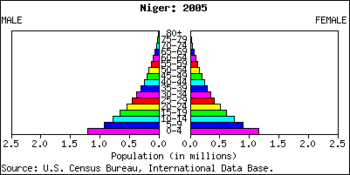Population structure in developing countries

The population structure in developing countries differs significantly from the population structure in industrialized countries . The investigation is essentially limited to the age structure of the population and the average life expectancy . The predominant age structure in developing countries describes a triangle or pagoda shape. This form results from the decrease in the population per age group typical of developing countries with increasing age, a high birth rate and high infant and child mortality .
In the five-phase demographic transition model, most developing countries are in phase 2 or 3: high birth rates and high, but mostly falling, mortality .
The high birth rate is due to several factors:
- high child mortality
- poor education , especially among women
- missing or inadequate contraceptive measures
- traditional and religious values (children as a status symbol)
The high mortality is due to a poor supply situation , poor hygienic conditions and a lack of medical care. Also, civil wars and military conflicts in developing countries contribute to the high mortality. In spite of this, infant and child mortality has decreased in all developing countries in recent years, which has led to a so-called population explosion in the countries concerned due to the continued high birth rate .
The current growth of the world population in connection with the question of the carrying capacity of the earth is considered to be one of the central challenges of our time. However, a slowdown in growth has now been achieved. At the end of the 1980s the absolute growth of the world population was still 86 million a year, this rate is expected to decrease to 33 million a year by 2050. 98% of this growth is taking place in developing countries.
